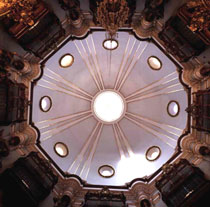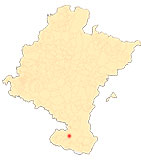The Church of the Company of Mary (Tudela)
By Ricardo Fernández Gracia
The author of project: Fr José Alberto Pina
Fray José Alberto Pina, author of numerous churches in Aragón, of the Bishop's palace in Albarracín and who would later achieve deserved fame in Valencian lands, where he became position of other important ones in Játiva and projected models for the Pious Schools of Valencia, which earned him the unanimous concession in 1769 of the degree scroll of member of the Academy of San Carlos.
Father Pina resided in the convent of Tudela at least between 1733 and 1735 and his name must be associated with some of the buildings in Tudela during those decades, such as the Jesuit sacristy -today San Jorge- and above all the church of the Compañía de María, a true example of Italian Baroque plan combined with a decorative plan clearly of the land. From Tudela, he traveled to appraise or plan different buildings in Cascante, Villafranca and Tarazona.
The attribution of the general project to Fray José Alberto Pina is supported by the presence of the religious in the convent of the Ribera de Navarra and by some indirect documents. On the one hand, on August 25, 1733, he declared on the existing differences between the nuns and the chantre and canon Don Agustín de Ychaso. In the aforementioned document, he is clearly referred to as "architecto de fábrica". The following year, specifically on March 12, he testified in favor of the nuns of the teaching together with Juan Antonio Marzal in the lawsuit that they had with Antonio Merino about the location of a window, a fact that speaks of the familiarity and confidence of the nuns with the tracista friar. In the report that he made quotation some books like the Government and policy of factories of Teodoro de Ardemans, as well as the Ordinances of Juan de Torija.
-
PUIG Y ARBELOA, M. C., review histórica de la fundación del convento de religiosas de la Compañía de María y teaching de Tudela, Madrid, Imprenta a position de D. R. P. Infante, 1876.
-
FOZ Y FOZ, M. P., La revolución pedagógica en Nueva España 1754-1820 (María Ignacia de Azlor y Echeverz y los colegios de la teaching), Madrid, high school Gonzalo Fernández de Oviedo, 1981.
-
ECHEVERRÍA GOÑI, P., and FERNÁNDEZ GRACIA, R., "La arquitectura religiosa de los siglos XVI al XVIII en Navarra", Ibaiak eta Haranak. guide del Patrimonio artístico y paisajístico. Navarra, vol. VIII, San Sebastián, Etor, 1991.
-
AZANZA LÓPEZ, J. J., Arquitectura Religiosa Barroca en Navarra, Pamplona, Government of Navarre, 1996.
-
FERNÁNDEZ GRACIA, R., The Baroque altarpiece in Navarre. Pamplona, Government of Navarre, 2003.
-
CARRASCO NAVARRO, C., Los palacios barrocos de Tudela. Arquitectura y Nobleza, Tudela, Castel Ruiz- M. I. Ayuntamiento de Tudela, 2014.












